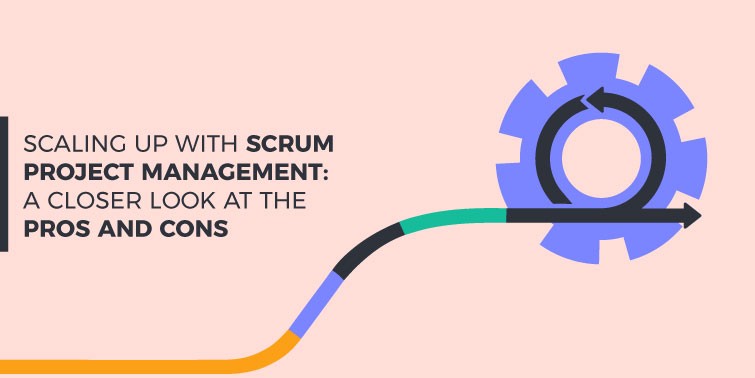Scaling Up with Scrum Project Management: A Closer Look at the Pros and Cons
Scrum Project Management is quite popular now. Many organizations are trying to understand which management methodology is better.
Which are the pros and cons of Scrum Project Management?
Today we will understand what Scrum is and the main advantages and disadvantages of the methodology in general.
What is Scrum?
Scrum is one of the most popular Agile frameworks used to develop complex products. It is quite different from another popular methodology – Waterfall. We have previously discussed the Agile Project Management vs Waterfall methodologies.
Now let us focus on Scrum Project Management. “Scrum” is not an acronym. The whole procedure of this methodology is like a team of players trying to get the ball. It is inspired by a scrum in rugby. The team members gather and discuss what to do to move the ball forward during a rugby game. So, in Scrum Project Management teams often gather to share their success related to the project with one another. The team discusses how far they have come, what the next steps are and what challenges there have been. The meetings are usually brief and informative.
Think about Scrum as a way to get work done as a team in small pieces at a time. There are continuous experimentation and feedback loops in this methodology to learn and improve all the time. Scrum helps us to deliver value incrementally in the most collaborative way. As an Agile framework, Scrum provides just enough structure for teams to integrate into how they work. It also adds the right practices to the whole procedure and history.
To fully understand and appreciate the importance of Scrum, you need to understand how Agile development works. We have already talked about Project Management with Agile Principles before. So, Agile is not a framework, nor a way of software development. Agile development is a list of principles that give support to the evolution of software development methods. It is all about following different methods and using certain tools in order to develop a software product. Scrum Project Management is one of these methods. Its main application is the development of complex systems and products. “Do, check then adapt” are the main principles of Scrum. It ensures optimum productivity and results.
The whole idea of Scrum Project Management is to give the users what they are looking for. This can be achieved by Sprints.
What are Sprints?
A Sprint is a Scrum event that fences in all the other Scrum events. These are fixed periods of work lasting for 1 month or less in general. They create consistency and ensure short iterations in order to give feedback. These kinds of processes inspect how the work is done and what is currently being worked on. If the cycles last longer, the rhythm of frequent feedback can be lost. The longer the sprint, the bigger there is a risk for the project itself.
All the necessary work is done via Sprints.
During the Sprint:
Project Scope can be discussed and set with the product owner,
Quality does not get worse,
The product backlog is refined, etc.
Thanks to the Sprints there is a bigger predictability ensuring that the Scrum Project Management team adapts to the product goal. Sprints ensure that increments of valuable work are delivered in short cycles of 1 month or less.
Who benefits from applying Scrum?
Scrum can be a good choice for a big variety of projects and businesses.
Here are the main ones who can benefit from Scrum:
Businesses that value results:
If you value results over documented progress, Scrum Project Management is the right choice for you.
Companies that cater to the customers:
If your product is customized according to the customers’ preferences and specifications, Scrum is right for you.
A little complicated projects:
If your team needs to complete the backlog, Scrum Project Management with its Sprints is a great fit.
Different Roles in Agile Scrum Methodology
There are two sets of roles in Agile scrum methodology: core and ancillary roles.
The 3 core roles are: scrum master, product owner and scrum team. They are all committed to the scrum project.
Scrum Master: He/she is the facilitator of the scrum development process. The scrum master makes sure all the rules are being followed as intended. They also hold the daily meetings that play an essential role in the project. Scrum Project Management would be quite weak without a Scrum Master. One of the main responsibilities of a Scrum Master is inspiring the team. He/she also ensures that the team has all the conditions to reach the common objectives.
Product Owner: These are the stakeholders, who are typically the customers. The product expectations are determined by the product owner. He/she records the changes necessary to be made, administers a scrum backlog.They introduce the main to-do-list for the scrum project. The product owner prioritizes the goals for each Sprint based on the stakeholders’ values.
Scrum Team: The team includes 3-9 self-organized individuals with business, design and analytical skills. They have to carry out the main work, solve problems and produce the products. They are all jointly responsible for the final goals of each Sprint. The improvement of each feedback every time is one of the main goals of the team.
Ancillary roles include other stakeholders who are involved in the project. They are not committed to it, though. These are usually customers, management, and executive team members. They are involved in the roles for the purpose of consulting, reporting progress and gathering feedback regarding the project.
The Pros of Scrum Methodology
Okay, let’s focus on the advantages of using the Scrum methodology.
#1 It is adaptable
If you want to deliver the best to the customer, Scrum Project Management is an accurate choice. It is done via regular feedback during Sprint meetings. Each and every comment about the success of the project is evaluated and taken into account. With the outcome the adaptation is much easier for the company.
#2 It maintains transparency
Scrum methodology is always transparent. Even if there is a slight change in any process, it is visible to everyone. This is why the team needs to share all the necessary information transparently.
#3 It is quite simple
The framework of Scrum Project Management is quite concise and easy to comprehend.
#4 It avoids mistakes
Scrum methodology rectifies errors as it promotes transparency and regular feedback from the customers.
#5 It ensures better Return on Investment
Since the results of this methodology are derived quickly, revenue as well as other benefits come sooner.
#6 There is a focused approach
Scrum Project Management is concentrated on prioritizing features mostly to be used. If the customer considers this or that feature as a priority, Scrum gives huge attention to it.
The Cons of Scrum Methodology
Of course, pros are always accompanied by some cons.
Let’s now have a look at some cons of the methodology.
#1 Meetings, meetings
Regular meetings are great for optimum performance, but they often take a lot of time.
#2 What if someone is absent?
If any of the team members is absent, there is a huge risk for the company. The success of the project depends on all of the team members.
#3 There are always changes
The working methods are flexible here. One day you know what you have to do, the next day things might change.
#4 The team size
Scrum methodology is ideal for maximum nine members. The results might have been much better if the team size increased.
#5 No deadline
The absence of a deadline may harm the overall project. When you have a time limit for the deliverance of products, it often results in a slower pace of work.
#6 No experience? That might be a problem
Scrum methodology works only with experienced people. The more experienced you are, the more chances you have to succeed in such a project.
Should I study Scrum Methodology or not?
Agile has increased the demand of IT professionals now. Especially, if you have solid knowledge of Kanban, Lean, Scrum etc. If you want to be one of those in-demand professionals in the future, you’d better start now!
By studying Scrum methodology you will improve your project management as well as collaborative and communication skills. You will be better at risk management and will deliver higher-quality products and services to the customers.
So, as you see, generally there are both pros and cons regarding Scrum Project Management. In order to understand whether or not you want to implement it, you should take into consideration both sides.
Here, at BDG we organize intensive and up-to-date Agile Scrum Master Certification training courses. Take a look and let us know if you would like to be a part of the upcoming course.




